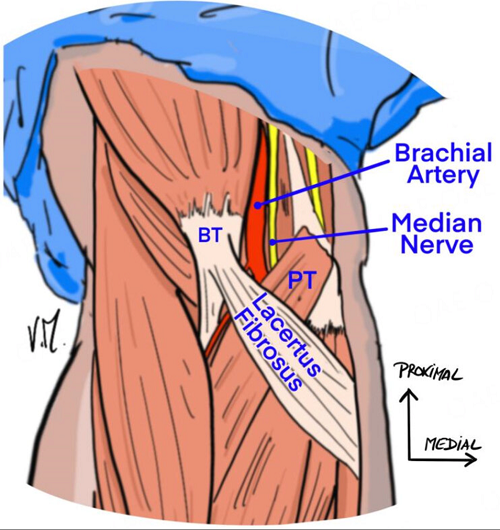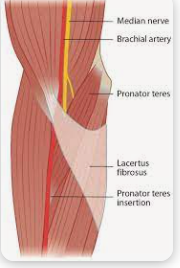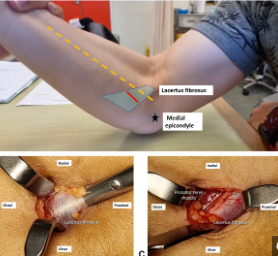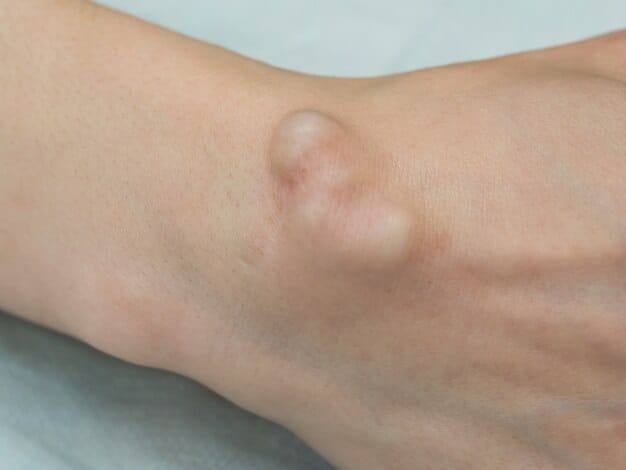
Lacertus Fibrosus: If you still feel numbness after carpal tunnel surgery, it means maybe you have Lacertus fibrosus syndrome !
Lacertus fibrosus syndrome is an infrequent median nerve compression disorder generally characterized by impairment of hand strength and hand endurance.
Lacertus Fibrosus Syndrome occurs when the Lacertus fibrosus at the elbow thickens and compresses the median nerve. This causes pain, numbness, and weakness in the arm. If left untreated, it affects daily activities. Dr. Marouane Bouloudhnine, a top orthopedic surgeon in Dubai, specializes in treating median nerve compression. In this blog, he explains the condition, its symptoms, and when surgery may be needed to provide relief.
According to the American Academy of Orthopedic Surgeons, LFS is a relatively rare condition, affecting only about 1% of the population. However, it is important to be aware of the symptoms of LFS and to seek medical attention if you are experiencing them.
What is Lacertus Fibrosus?
Lacertus Fibrosus Syndrome (LFS) is a rare and poorly understood condition characterized by the contraction of the lacertus fibrosus.
The Lacertus fibrosus is a fibrous band located at the elbow. It connects the supinator muscle to the medial epicondyle of the humerus.

The median nerve travels from the upper arm, passing beneath the Lacertus fibrosus at the elbow. It plays a key role in stabilizing the elbow but sometimes thickens. This thickening compresses the median nerve causing pain, numbness, and weakness in the affected limb.
The median nerve is a major nerve that supplies sensation and movement to the hand and forearm.
Causes of Lacertus Fibrosus Syndrome (LFS):
Causes of Lacertus Fibrosus Syndrome (LFS):
The exact cause of LFS is often unknown, but several factors may contribute to its development:
- Repetitive Movements: Activities that involve repeated bending and extending of the elbow, such as typing, playing instruments, or certain sports, can put stress on the Lacertus fibrosus.
- Occupation: People in jobs that require frequent arm movements, such as construction workers, mechanics, and factory workers, may be at higher risk.
- Anatomical Variations: Some individuals naturally have a thicker Lacertus fibrosus, increasing the likelihood of nerve compression.
- Trauma or Injury: A history of elbow injuries or trauma can sometimes lead to LFS.
Common symptoms include:
- Numbness and heaviness in the forearm
- Pain that radiates to the shoulder
- Weakness in the thumb and index finger
- Difficulty with fine motor tasks like handling small objects
These symptoms are confused with carpal tunnel syndrome. However, median nerve compression at the elbow typically doesn’t cause nighttime pain. In some cases, both conditions coexist, leading to Double Crush Syndrome. This occurs when the nerve is compressed at both the wrist and elbow. A correct diagnosis is important for the right treatment.
When is Surgery Necessary?
In mild cases of LFS, surgery may not be needed. Alternative treatments provide relief, including:
- Rest and Activity Modification: Reducing or stopping activities that worsen the symptoms helps reduce pain and inflammation.
- NSAIDs: Over-the-counter anti-inflammatory medications, such as ibuprofen relieve pain and reduce inflammation.
- Corticosteroid Injections: Injecting corticosteroids around the nerve reduces inflammation and provides temporary relief.
- Physical Therapy: Exercises guided by a physical therapist help improve flexibility, strengthen muscles, and support the median nerve.
- Splinting or Bracing: Wearing a splint or brace help immobilize the elbow, relieving pressure on the nerve.
However, if pain becomes severe or if there is a significant loss of strength, surgery is required.
Dr. Marouane Bouloudhnine, a leading hand-to-shoulder specialist in Dubai, performs minimally invasive surgery to release the compressed median nerve. His expertise ensures patients experience faster recovery and better results.
What Does the Surgery Involve?
Surgery for Lacertus fibrosus syndrome is an open procedure. Arthroscopy isn’t beneficial for this condition. If the patient also has Carpal Tunnel Syndrome, both surgeries can be done together.

The surgery involves:
- Regional anesthesia to numb the area.
- A 2 cm incision just below the elbow crease.
- Cutting the Lacertus fibrosus to release the compressed nerve.
- Checking the nerve and surrounding tissue for further issues.
The procedure offers
- Immediate pain relief.
- Strengthen the thumb, index finger, & wrist.
- Quicker recovery
However, mild discomfort around the incision lasts for a few weeks.
Recovery After Surgery
Patients experience a quick recovery after this surgery. The pain caused by the compression is usually relieved immediately. Rehabilitation exercises help regain full strength and mobility. Most patients return to normal activities within a few weeks.
Why Choose Dr. Marouane?
As a leading orthopedic surgeon in Dubai, Dr. Marouane Bouloudhnine specializes in hand and shoulder treatments. He has extensive experience treating Lacertus fibrosus syndrome and median nerve compression. His personalized approach ensures optimal outcomes for each patient.
Dr. Marouane’s advanced techniques and commitment to patient care make him a trusted name in orthopedic surgery. Whether you are an athlete or facing daily challenges due to nerve compression, Dr. Marouane provides the expertise needed for a full recovery.
Conclusion
If you are experiencing symptoms of median nerve compression, early treatment is crucial. With Dr. Marouane Bouloudhnine, you can trust in expert care and a quick recovery.
Contact Dr. Marouane’s clinic today to schedule a consultation and start your journey to relief.






